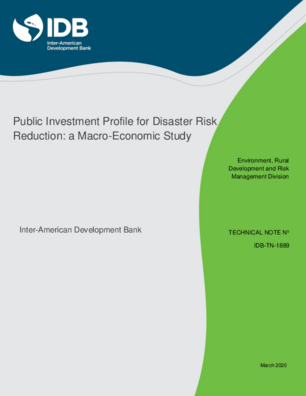Public Investment Profile for Disaster Risk Reduction: A Macro-Economic Study
Date
Mar 2020
The Inter-American Development Bank (IADB) carried out a study on “Development of a Public Investment Profile for Disaster Risk Reduction: A Macro-Economic Study” through the Technical Cooperation RG-T2434 from 2014 to 2017. Its objective was to develop a technical instrument to carry out comparative analyses on the economic benefits of different investment measures in Disaster Risk Reduction (DRR), assessing the benefits from public investments that seek to mitigate the economic and social impacts of disasters in a sustainable way. The instrument supports decision-making for the allocation of public budget to different strategies in disaster risk mitigation, risk retention and/or transfer (by considering different financial instruments) both, at national and local levels. This technical instrument is titled: Investment Profile for Disaster Risk Reduction (DRR Investment Profile).
This document presents a conceptual model to optimize the composition, among four possible options, to be financed for disaster risk reduction over different time periods: a) investment in risk mitigation measures, b) design of a reserve fund to cope with the immediate needs for emergency attention and restoration of basic services, c) engage on a contingent credit instrument to cover certain loss layers, and/or d) purchase insurance to transfer risk to a third party. Each combination of, and constitution among these options, is complemented with the estimation of its costs and benefits to choose the best one (i.e. the one that yields the highest ratio between benefits and costs, either subject to a budgetary constraint or not).
This document is organized as follows: Chapter 2 summarizes the findings of a literature review carried out to establish a basic knowledge for the development of the study. Chapter 3 proposes a conceptual model and, Chapter 4 presents the methodological framework to incorporate risk mitigation measures in this conceptual model. Finally, Chapter 5 addresses risk mitigation in more detail, proposing a methodology to generate the loss exceedance curves (LEC) that account for mitigation measures. The model seeks to reflect the changes in the LEC through variations in specific parameters.
This document presents a conceptual model to optimize the composition, among four possible options, to be financed for disaster risk reduction over different time periods: a) investment in risk mitigation measures, b) design of a reserve fund to cope with the immediate needs for emergency attention and restoration of basic services, c) engage on a contingent credit instrument to cover certain loss layers, and/or d) purchase insurance to transfer risk to a third party. Each combination of, and constitution among these options, is complemented with the estimation of its costs and benefits to choose the best one (i.e. the one that yields the highest ratio between benefits and costs, either subject to a budgetary constraint or not).
This document is organized as follows: Chapter 2 summarizes the findings of a literature review carried out to establish a basic knowledge for the development of the study. Chapter 3 proposes a conceptual model and, Chapter 4 presents the methodological framework to incorporate risk mitigation measures in this conceptual model. Finally, Chapter 5 addresses risk mitigation in more detail, proposing a methodology to generate the loss exceedance curves (LEC) that account for mitigation measures. The model seeks to reflect the changes in the LEC through variations in specific parameters.




